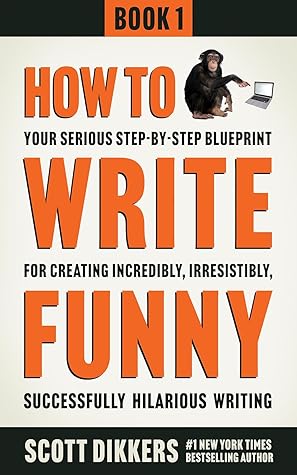More on this book
Community
Kindle Notes & Highlights
Read between
December 1, 2020 - January 24, 2021
To paraphrase E. B. White, comedy is like a frog—once you start dissecting it, it’s not funny.
Sometimes cutting a word or two can make a line twice as funny, or turn an unfunny line into a funny one.
Come up with 10 ideas for getting your writing in front of readers faces in ways that would be incredibly fun for both you and them.
There’s only one thing absolutely required for humor to exist, and that is surprise.
Because surprise is the core element of all humor, clichés must be avoided in all humor writing.
Snark is essentially Conversational, but with the added layer of smart-alecky sarcasm, the wry attitude of someone who’s plugged into the most desirable trends.
Snark is identifiable for its brazen use of clichés borrowed from other Snark writing.
Clichés, almost more than the too-hip attitude, are what define this style of writing. Like other humor clichés, those of Snark are cyclical, but as of this writing, “Best. [Insert a thing]. Ever.” (with periods between each word) is enjoying widespread use. Faux-Conversational words and phrases like “Welp,” (as a version of “Well”), “I know, right?,” “Ya think?,” “Hells no,” and “Wow. Just wow,” imply a conversation with the reader that’s not happening.
One of the problems with Snark nowadays is that it’s overused, and therefore writers in this category have difficulty standing out from the crowd. Mike Nelson (of Mystery Science Theater 3000 fame) has written some very funny essays and books in this style. John Hodgman and Sarah Vowell use the form skillfully, though a lot of their writing hits more sophisticated notes as well.
Satire has something to say—something important—that’s hidden in the literal text. In the other categories, humor itself is the end goal.
Yes, readers are laughing at Satire, but they’re also getting this secret message. This message makes the material funnier, the laughs more satisfying.
In any sophisticated writing, there’s more there than just the literal words on the page. There’s something else that those words aren’t saying, but rest assured it’s being communicated clearly to any reasonably intelligent reader. What’s being communicated is the Subtext.
All good jokes have Subtext, as do all good comedy articles, short stories and novels. But in the less-sophisticated humor categories, the Subtext has nothing to say.
Subtext in Satire is a value judgment or opinion held by the writer. In the best satirical writing, the Subtext is universal, something that just about anyone can relate to. In the very best writing, it points out something wrong with the world, a fatal flaw or weakness in humanity or the universe.
Science fiction is essentially Satire but instead of using humor to communicate Subtext, it uses the awe of science, the future, aliens, or worlds yet unknown.
As a writer, you have one mission: to communicate ideas to readers. Your Subtext is where those ideas are.
A common flaw in a lot of unsuccessful humor is that the contrast inherent in the joke is not heightened enough.
By contrast, when you use Irony as a literary device in Satire, you pretend to adopt the opposite of your true message with absolute conviction, and you play it straight.
The idea behind Character is simple: When a comedic character acts on his, her or its clearly defined traits, a joke results.
Most stand-up comedians use the Character Funny Filter to create a character for themselves, their “persona.” These are case studies in the Character Funny Filter and how simple it is to use: Bill Burr is the psycho who ironically makes sense; Marc Maron is the anxiety-ridden over-sharer; David Spade is the smartass.
A nice mix of traits in comedy often involves some Irony. For example, an insurance actuary who wishes he were a football player, yet is a weakling constantly stricken with illness.
Note how Dangerfield establishes his one trait (that he gets no respect), then presents an example of his acting in accordance with that one trait (or in his case, his being acted upon in accordance with the trait, which is another way to reveal the trait).
Hyperbole, more than any other Funny Filter, feels like real joke-writing.
You can see how simple Hyperbole is: just exaggerated Subtext and make a point with gusto.
The contrast you create between your sober delivery and your hilarious material adds an important layer of Irony to your humor.
The difference between a groaner and a sophisticated, genuinely funny Wordplay joke is often as simple as that: a groaner is Wordplay without Subtext, a successful joke is Wordplay with Subtext, especially astute Subtext.
You find Reference by observing life and writing down anything you notice that you think other people might understand or relate to.


